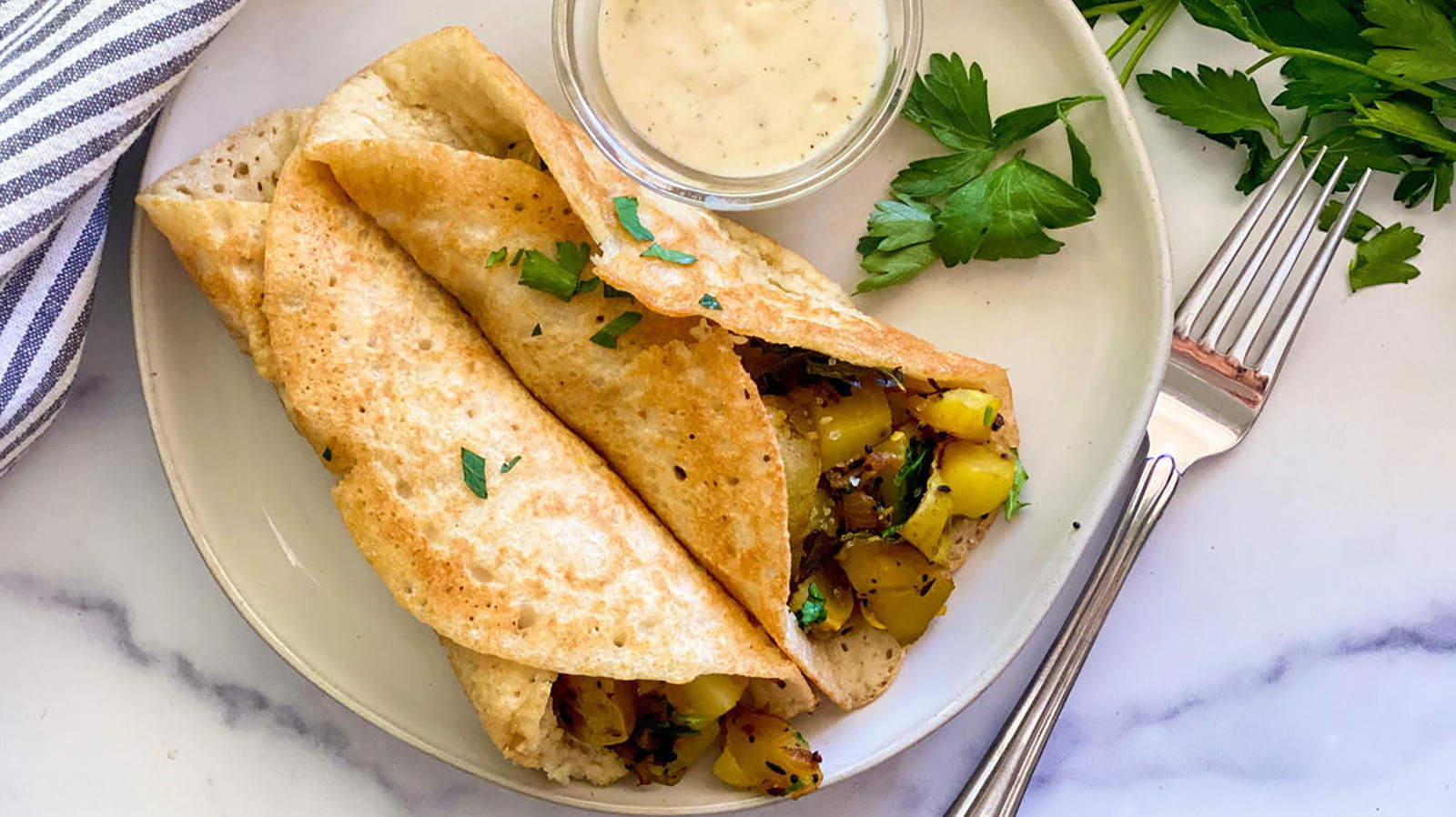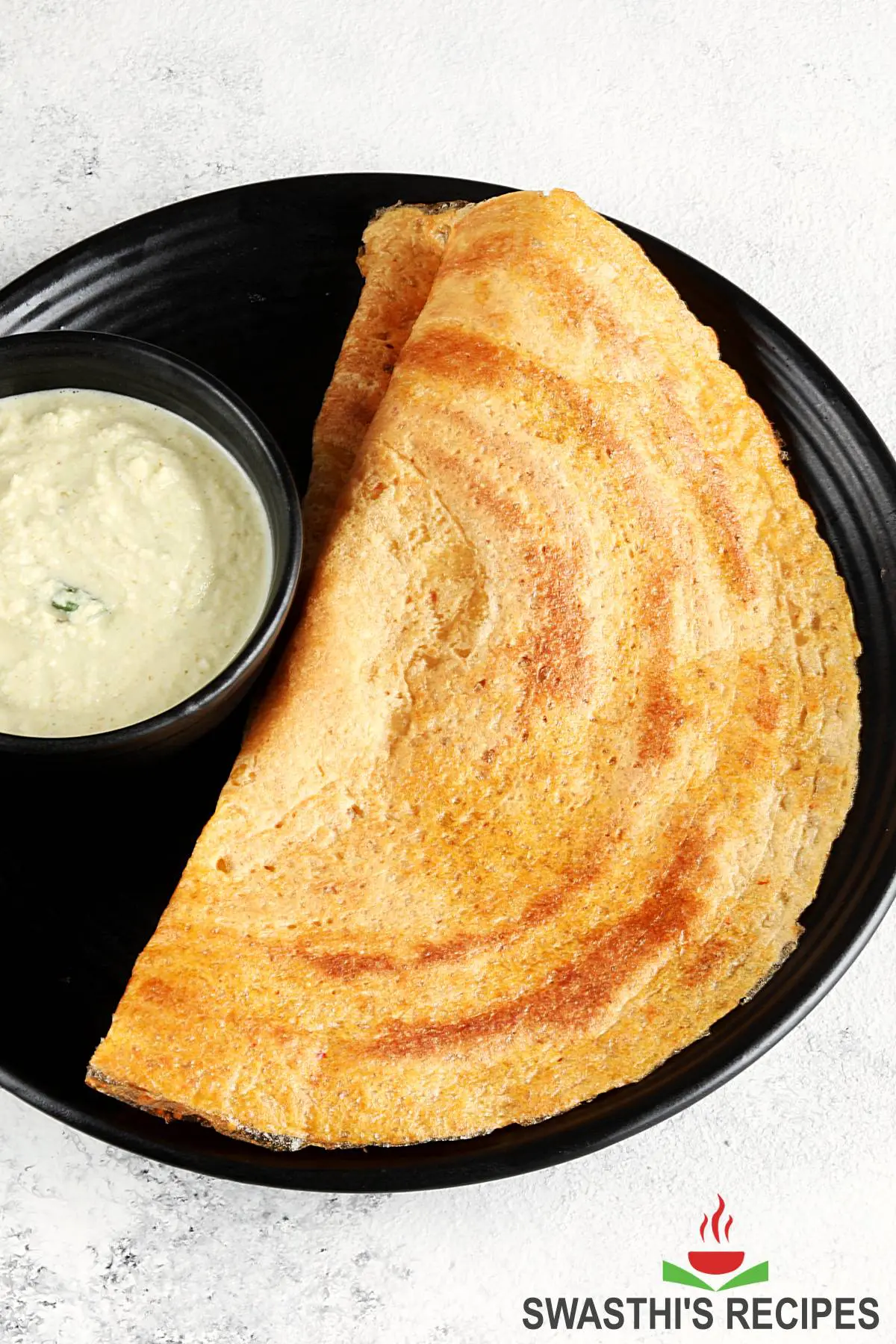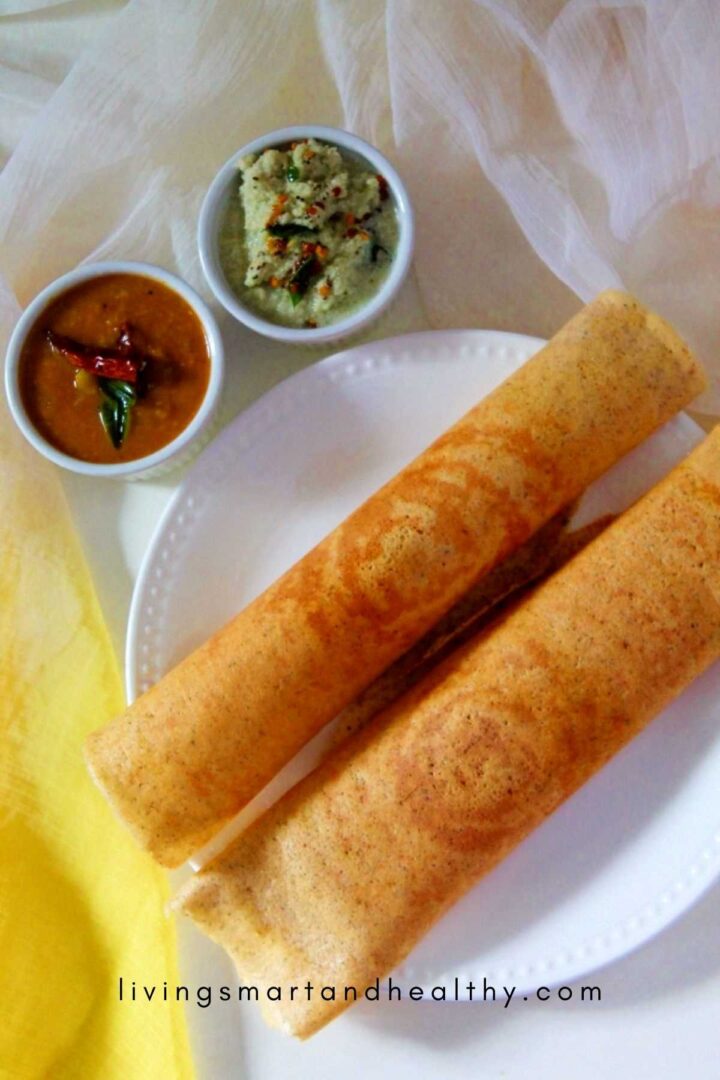
Introduction
Background Information On Dosa And Its Popularity
Dosa is a traditional Indian pancake that is made from a fermented batter of rice and lentils. It originated in South India but has gained popularity worldwide. Dosas can now be found in many Indian restaurants around the world, and people from different cultures have started enjoying this delicious dish.
Dosas come in various forms, ranging from plain dosas to masala dosas stuffed with a savory potato filling. They are typically served with coconut chutney and sambar, a lentil-based vegetable stew. The versatility of dosas makes them a favorite breakfast option, especially among those who follow a vegetarian or vegan diet.
The Importance Of Protein In A Balanced Diet
Protein is an essential macronutrient that plays a crucial role in our overall health and well-being. It is responsible for building and repairing tissues, producing enzymes and hormones, and supporting a healthy immune system. Consuming an adequate amount of protein is particularly important for individuals who lead an active lifestyle or engage in regular physical exercise.
Protein is also essential for maintaining and building muscle mass, which is especially beneficial for athletes and individuals looking to improve their body composition. Including protein-rich foods in your diet can help you feel fuller for longer, control cravings, and support weight management.
Dosa As A Protein-packed Breakfast Option
Dosa is not only a delicious breakfast option but also a protein-packed one. While the exact protein content may vary depending on the type and ingredients used, dosas are generally a good source of protein.
For example, a paneer dosa is not only rich in protein but also provides essential nutrients like beta carotene and lutein. The fermentation process involved in making dosa increases the vitamin B and vitamin C content, adding to its nutritional value.
It’s important to note that the protein content of dosas can be enhanced further by adding ingredients like lentils, beans, or tofu to the batter. This allows individuals to customize their dosas according to their dietary preferences and nutritional requirements.
In conclusion, dosa is a popular and protein-packed breakfast option that can be enjoyed by people from all walks of life. Its versatility and nutritional benefits make it a great choice to start your day on a protein-rich note. So, the next time you’re looking for a delicious and nutritious breakfast option, consider having a dosa.
What Is Dosa?
Description Of Dosa And Its Ingredients
Dosa is a traditional Indian pancake that originated in South India. It is made from a fermented batter of rice and lentils, which gives it a unique flavor and texture. The key ingredients of dosa are rice and black gram, making it a good source of protein. Dosas come in various forms, ranging from plain dosas to masala dosas stuffed with a savory potato filling. They are typically served with coconut chutney and sambar, a lentil-based vegetable stew.
Traditional And Modern Variations Of Dosa
Over the years, dosas have evolved and gained popularity worldwide. Traditional dosas are made with rice and lentils, but modern variations have emerged with different ingredients and flavors. Some popular variations include:
- Paneer Dosa: This dosa is made with paneer (Indian cottage cheese), which adds protein and essential nutrients like beta carotene and lutein.
- Lentil Dosa: Lentils, such as moong dal or chana dal, can be added to the batter to increase the protein content of dosas.
- Tofu Dosa: For those following a vegan diet, tofu can be used as a protein-rich alternative to paneer.
- Vegetable Dosa: This dosa is loaded with a variety of vegetables, such as carrots, peas, and bell peppers, adding vitamins and minerals to the dish.
The fermentation process involved in making dosa not only enhances its flavor but also increases the vitamin B and vitamin C content, adding to its nutritional value. With its versatility and nutritional benefits, dosa has become a popular breakfast option for people from all walks of life. Whether you’re a vegetarian, vegan, or simply looking for a protein-packed breakfast, dosa is a delicious and nutritious choice to start your day.
Nutritional Content Of Dosa
Overview Of The Nutritional Profile Of Dosa
Dosa is a traditional Indian pancake made from fermented batter of rice and lentils. It is a versatile dish that can be enjoyed in various forms, with different fillings and flavors. The key ingredients of dosa are rice and black gram, making it a good source of protein. It is also relatively high in carbohydrates and moderate in fat content. Dosas are typically served with coconut chutney and sambar, adding to their overall nutritional content.
Dosa As A Source Of Carbohydrates And Fiber
Dosa provides a significant amount of carbohydrates, which are the primary source of energy for our body. It contains about 65% carbohydrates, making it a filling and satisfying meal option. The fermentation process involved in making dosa also enhances the fiber content of the dish. Fiber is essential for maintaining a healthy digestive system and may help in reducing the risk of certain diseases like heart disease and diabetes.
It is important to note that the nutritional content of dosa can vary depending on the specific recipe and the accompaniments used. For a balanced meal, it is recommended to eat dosa with protein-rich foods like peanut or coconut chutney, which can further enhance its nutritional value.
Overall, dosa is a tasty and nutritious choice for breakfast or any other meal of the day. Its combination of protein, carbohydrates, and fiber makes it a filling and satisfying option. If you are looking to incorporate more protein-rich foods into your diet, there are various recipes available that combine dosa with ingredients like paneer, lentils, tofu, and vegetables to further enhance its nutritional content.

Protein In Dosa
Explanation Of The Protein Content In Dosa
Dosa, a traditional Indian pancake made from fermented rice and lentil batter, is not only a delicious dish but also a good source of protein. Protein is an essential macronutrient necessary for various functions in the body, including building and repairing tissues, producing enzymes and hormones, and supporting the immune system.
While the exact protein content of dosa can vary depending on the specific recipe and serving size, on average, it contains about 12% protein. This makes dosa a decent source of protein, especially when combined with other protein-rich accompaniments like peanut or coconut chutney.
Types Of Lentils Or Legumes Used In Dosa Batter
The protein content in dosa comes from the lentils or legumes used in the batter. Dosa is typically made with a combination of rice and black gram (also known as urad dal). However, there are also variations of dosa that use different types of lentils or legumes, such as mixed dal dosa.
Mixed dal dosa, as the name suggests, is made with a mix of lentils like urad dal, chana dal (split Bengal gram), moong dal (split green gram), and toor dal (pigeon pea). This combination of lentils increases the protein content of the dosa and provides a wide range of nutrients.
Including different lentils in the dosa batter not only boosts the protein content but also enhances its nutritional profile. Lentils are rich in fiber, vitamins, and minerals, making them a healthy addition to the dosa.
In summary, dosa is a versatile and nutritious dish that offers a decent amount of protein. By incorporating different types of lentils or legumes in the dosa batter, such as with mixed dal dosa, you can further enhance its protein content and enjoy a protein-packed meal.
Health Benefits Of Protein
The Role Of Protein In Weight Loss And Muscle Maintenance
Protein plays a crucial role in weight loss and muscle maintenance. Including protein-rich foods like dosa in your diet can help support your weight loss goals. Protein helps build and repair tissues, including lean muscle mass. By maintaining muscle mass, you can improve your overall body composition and increase your metabolic rate.
Protein’s Effect On Metabolism And Feelings Of Fullness
Protein also has a positive effect on metabolism and feelings of fullness. When you consume protein, your body requires more energy to digest and absorb it compared to carbohydrates and fats. This process, known as the thermic effect of food, can boost your metabolism and increase calorie burning.
Additionally, protein has a satiating effect, which means it can help you feel fuller for longer periods. This can prevent overeating and promote better portion control, ultimately aiding in weight management.
Including protein-rich dosa in your diet can provide you with these health benefits. The lentils or legumes used in dosa batter are excellent sources of plant-based protein. They not only increase the protein content but also provide essential nutrients like fiber, vitamins, and minerals.
By incorporating different types of lentils or legumes in your dosa batter, such as with mixed dal dosa, you can further enhance the protein content and enjoy a protein-packed meal. Just remember to consider the overall balance of your diet and incorporate a variety of other nutritious foods along with dosa to meet your daily protein needs.
In conclusion, dosa can be a healthy addition to your diet, thanks to its protein content and other beneficial nutrients. However, it is always important to consume a well-rounded and balanced diet that includes a variety of foods to meet your nutritional needs.
Potential Downsides Of Eating Dosa
Addressing The Disadvantages Of Consuming Dosa
While dosa offers several health benefits, it is important to consider some potential downsides. Here are a few factors to be aware of:
- High Carbohydrate Content: Dosa primarily consists of rice and lentils, making it relatively high in carbohydrates. Consuming excessive carbohydrates without balancing them with other nutrients can contribute to weight gain and blood sugar imbalances.
- Gluten Intolerance: Traditional dosa batter is made from a combination of rice and lentils, making it gluten-free. However, some modern variations of dosa may include wheat or other gluten-containing ingredients. Individuals with gluten intolerance or celiac disease should be cautious of such variations.
- High Sodium Levels: The fermentation process of dosa batter often requires the addition of salt. As a result, dosa can be high in sodium. A high-sodium diet can increase the risk of hypertension and other cardiovascular issues. It is essential to monitor your overall sodium intake and opt for low-sodium alternatives when possible.
Health Concerns And Nutritional Imbalances
It is crucial to address potential health concerns and nutritional imbalances that may arise from consuming dosa:
- Micronutrient Deficiencies: While dosa does provide some essential nutrients, it may lack certain vitamins and minerals. For instance, dosa may not be a significant source of vitamins A, C, and B12, iron, and zinc, which are important for overall health. It is important to ensure a well-rounded diet that includes a variety of nutrient-dense foods.
- Filling but not always satisfying: While dosa is often filling due to its high carbohydrate and fiber content, it may not provide long-lasting satisfaction for everyone. Some individuals may find themselves craving more substantial meals or experiencing hunger pangs shortly after consuming dosa. Adding protein-rich sides or incorporating nutrient-dense fillings can help enhance satiety.
In conclusion, dosa can be a delicious and nutritious addition to your diet. However, it is crucial to be mindful of potential downsides, such as high carbohydrate content and the risk of gluten cross-contamination. To address nutritional imbalances, it is important to consume a diverse range of foods to ensure an adequate intake of vitamins, minerals, and other essential nutrients. Consulting a healthcare professional or registered dietitian can also provide personalized guidance on incorporating dosa into a well-balanced diet.

Maximizing The Nutritional Value Of Dosa
Suggestions For Incorporating Nutrient-dense Fillings In Dosa
While dosa can be a delicious and nutritious addition to your diet, there are a few ways to maximize its nutritional value. One of the best ways is to incorporate nutrient-dense fillings into your dosa. Here are some suggestions:
- Paneer: Paneer is a great source of protein and can be a delicious filling for your dosa. It provides essential amino acids that support muscle growth and repair.
- Vegetables: Adding a variety of vegetables to your dosa can boost its nutritional content. Vegetables like spinach, bell peppers, and onions are rich in vitamins, minerals, and fiber.
- Lentils: Lentils are not only a great source of protein but also high in fiber. They provide essential nutrients like iron and folate.
- Chickpeas: Chickpeas, also known as garbanzo beans, are another excellent choice for filling your dosa. They are packed with protein, fiber, and other beneficial nutrients.
Adding Vegetables And Lean Proteins For Added Health Benefits
In addition to nutrient-dense fillings, you can further enhance the health benefits of dosa by incorporating vegetables and lean proteins:
- Leafy greens: Adding leafy greens like spinach or kale to your dosa batter can increase its vitamin and mineral content. These greens are particularly rich in vitamins A, C, and K.
- Fish or chicken: Incorporating lean proteins like fish or chicken into your dosa can provide essential amino acids and omega-3 fatty acids, which are beneficial for heart health.
- Beans: Including beans like black beans or kidney beans in your dosa can add fiber, protein, and various vitamins and minerals.
- Avocado: Adding slices of avocado to your dosa can provide healthy fats and enhance its creaminess.
By incorporating these nutrient-dense fillings, vegetables, and lean proteins into your dosa, you can maximize its nutritional value and make it an even healthier meal option. Remember to choose fresh and high-quality ingredients for the best results.
Dosa And Weight Loss
Exploring The Potential Of Dosa In A Weight Loss Diet
Dosa can be a good option for those looking to lose weight due to its high protein and fiber content. Lentils or legumes used in dosa batter are rich sources of plant-based protein, which helps in maintaining muscle mass, boosting metabolism, and promoting a feeling of fullness. The fermentation process used to make dosa increases its fiber content, aiding in better digestion and promoting a sense of satiety. Additionally, dosa allows for a variety of fillings including vegetables and lean proteins, which further enhance its nutrient profile.
Balancing Dosa Consumption With Other Nutrient-rich Foods
While dosa can be a healthy addition to a weight loss diet, it’s important to balance its consumption with other nutrient-rich foods. Incorporating a variety of vegetables into your dosa can boost its nutritional content and provide vitamins, minerals, and fiber. Leafy greens like spinach or kale can increase the vitamin and mineral content of dosa. Lean proteins like fish or chicken can provide essential amino acids and omega-3 fatty acids, which are beneficial for heart health. Including beans like black beans or kidney beans adds fiber, protein, and various vitamins and minerals to your dosa. Adding slices of avocado can provide healthy fats and enhance creaminess.
By incorporating these nutrient-dense fillings, vegetables, and lean proteins into your dosa, you can maximize its nutritional value and make it an even healthier meal option. Remember to choose fresh and high-quality ingredients for the best results.
Overall, dosa can fit into a weight loss diet by providing protein, fiber, and a variety of nutrients. It is important to balance dosa consumption with other nutrient-rich foods to ensure a well-rounded diet. As always, it is recommended to consult with a healthcare professional or registered dietitian for personalized advice and guidance.
Dosa and Weight Loss
Exploring the potential of dosa in a weight loss diet
Dosa is a suitable choice for individuals aiming to lose weight due to its high protein and fiber content. The lentils or legumes used in dosa batter are excellent sources of plant-based protein, which can aid in maintaining muscle mass, boosting metabolism, and creating a feeling of fullness. Moreover, the fermentation process involved in making dosa increases its fiber content, thereby improving digestion and promoting a sense of satiety. Additionally, the ability to incorporate a variety of fillings into dosa, including vegetables and lean proteins, further enhances its nutrient profile.
Balancing dosa consumption with other nutrient-rich foods
While dosa can be a valuable addition to a weight loss diet, it is important to balance its consumption with other nutrient-rich foods. Enhancing the nutritional content of dosa can be achieved by incorporating a variety of vegetables, which provide vitamins, minerals, and fiber. Leafy greens such as spinach or kale can significantly increase the vitamin and mineral content of dosa. Lean proteins like fish or chicken can provide essential amino acids and heart-healthy omega-3 fatty acids. Furthermore, adding beans like black beans or kidney beans to dosa contributes fiber, protein, and numerous vitamins and minerals. Avocado slices can also be added for healthy fats and to enhance creaminess.
By incorporating these nutrient-dense fillings, vegetables, and lean proteins into dosa, you can maximize its nutritional value and make it an even healthier meal option. It is recommended to choose fresh and high-quality ingredients for the best results.
Summary of the protein presence in dosa
Dosa is a favorable choice for those seeking protein-rich meals. The combination of rice and lentils in dosa batter creates a complete protein with all the essential amino acids. This makes the dish a valuable protein source, particularly for individuals following vegetarian or vegan diets.
Tips for enjoying dosa in a healthy and balanced way
To enjoy dosa in a healthy and balanced manner, consider the following tips:
- Incorporate a variety of vegetables into your dosa for added nutritional content.
- Choose lean proteins such as fish or chicken to enhance the protein profile of your dosa.
- Include beans like black beans or kidney beans to increase fiber, protein, and nutrient content.
- Add slices of avocado for healthy fats and creaminess.
- Opt for fresh and high-quality ingredients to ensure the best results.
Remember, dosa can be a part of a weight loss diet by providing protein, fiber, and various nutrients. However, it is essential to balance dosa consumption with other nutrient-rich foods to ensure a well-rounded diet. For personalized advice and guidance, it is recommended to consult with a healthcare professional or registered dietitian.
Conclusion
In conclusion, dosa is a nutritious choice due to its high protein and fiber content, as well as its abundance of vitamins and minerals. Dosa can be beneficial for weight loss due to its ability to promote feelings of fullness and support muscle maintenance. By incorporating nutrient-dense fillings, vegetables, and lean proteins into dosa, its nutritional value can be maximized. However, it is crucial to balance dosa consumption with other nutrient-rich foods for a well-rounded diet. As with any dietary changes, consulting with a healthcare professional or registered dietitian is advised for personalized advice and guidance.
Does Dosa Have Protein: Protein Presence in the Dosa Delight
Q: What is dosa?
A: Dosa is a popular South Indian dish made from fermented rice and lentil batter. It is a thin, crispy pancake-like crepe that is typically served with a variety of chutneys and sambar.
Q: Does dosa have protein?
A: Yes, dosa contains a moderate amount of protein due to the lentils used in its preparation. Lentils are a rich source of plant-based protein, making dosa a good option for those looking to increase their protein intake.
Q: How much protein does dosa contain?
A: The protein content in dosa can vary depending on the recipe and the ratio of rice to lentils used. On average, a standard dosa contains around 3-4 grams of protein per serving.
Q: Is the protein in dosa complete?
A: The protein in dosa is not considered complete since it lacks some essential amino acids. However, when combined with other protein sources like sambar (a lentil-based vegetable stew) or chutney (made from coconut or legumes), it can form a complete protein.
Q: Can dosa be a good vegetarian protein source?
A: Yes, dosa can be a valuable vegetarian source of protein. It provides a substantial amount of plant-based protein, especially when combined with other protein-rich accompaniments like sambar or chutney.
Q: Is dosa a good option for protein intake in a balanced diet?
A: While dosa does contribute some protein to a balanced diet, it is important to remember that it should be consumed as part of a well-rounded meal plan. Including other protein sources such as legumes, nuts, dairy, or lean meats is recommended to ensure adequate protein intake.
Q: Are there any health benefits of eating dosa?
A: Yes, eating dosa can have several health benefits. Apart from being a good source of protein, dosa is also low in fat and cholesterol. It is rich in carbohydrates, fiber, and essential nutrients like iron, calcium, and B vitamins.
Q: Is dosa suitable for those on a gluten-free diet?
A: Yes, dosa can be a suitable option for individuals on a gluten-free diet. Traditional dosa recipes do not contain wheat or gluten. However, it is essential to ensure that the ingredients used and the cooking environment are free from any potential cross-contamination.
In conclusion, while dosa does contain protein, it should be incorporated into a balanced diet along with other protein sources to ensure sufficient intake. Enjoy this delicious South Indian delicacy as part of a wholesome meal for a nutritious dining experience!

New Indian Cafe offers delicious dining and takeout to Greenwood Village, CO.
New Indian Cafe is a cornerstone in the Greenwood Village community and has been recognized for its outstanding Indian cuisine, excellent service, and friendly staff.
Our Indian restaurant is known for its modern interpretation of classic dishes and its insistence on using only high-quality, fresh ingredients.